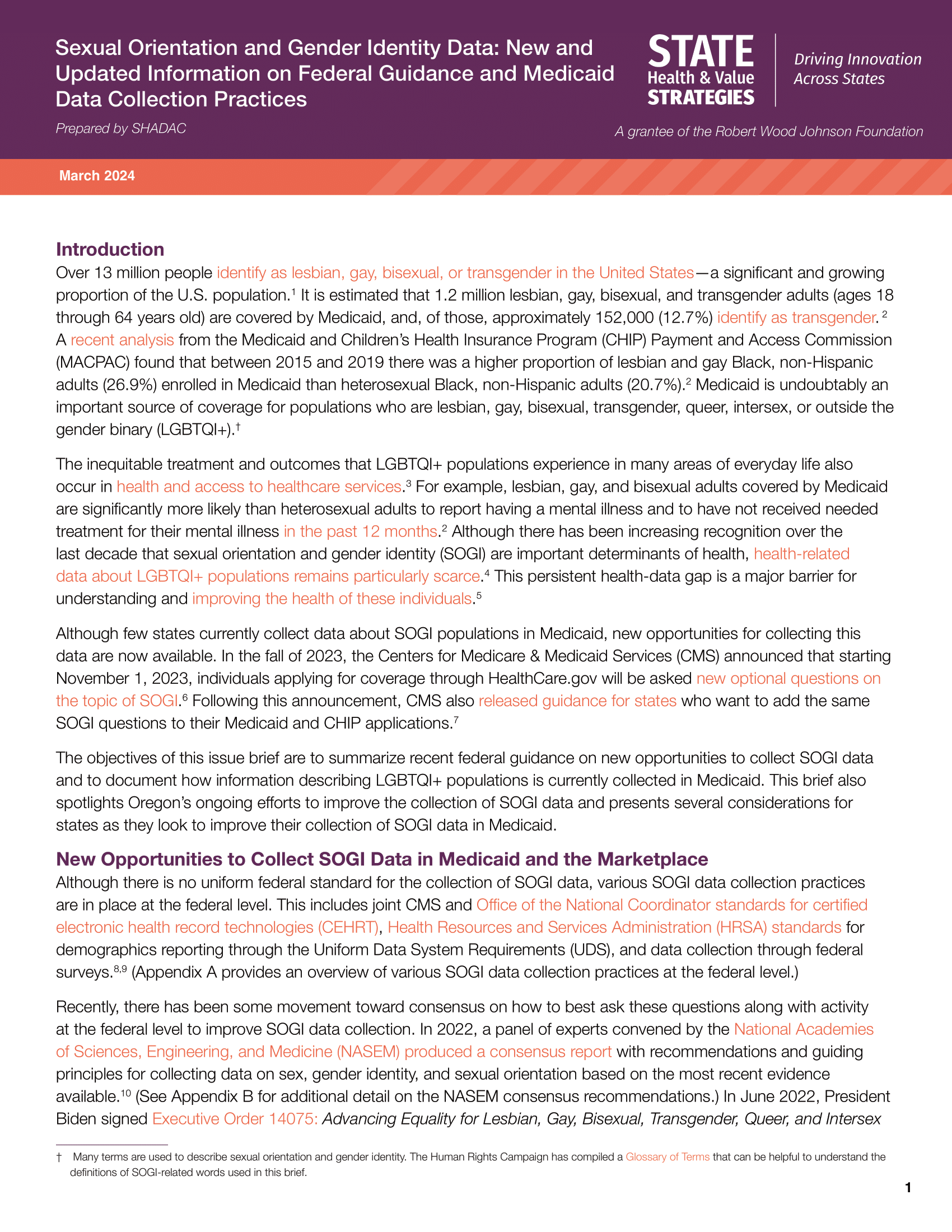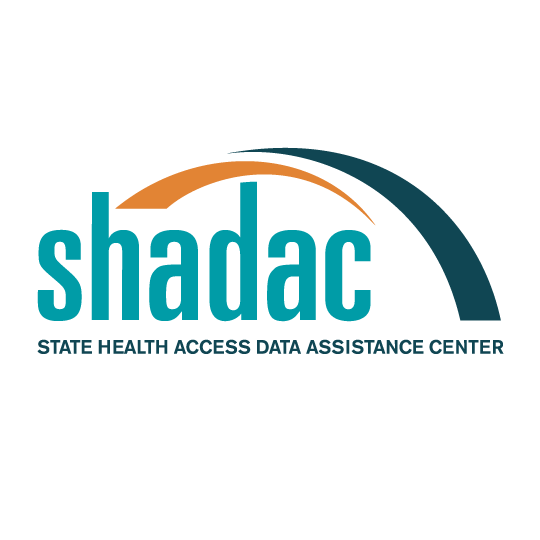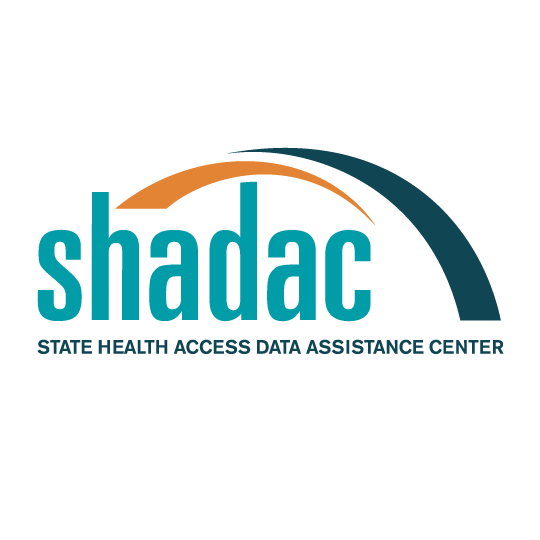Blog & News
LGBT Health Equity: Sexual Orientation and Gender Identity Data Resources and Information from SHADAC
July 02, 2024:- Less likely to have health insurance coverage
- Less likely to have a regular health care provider
- More likely to delay care
- More likely to report poor quality care and unfair treatment from providers
Sexual Orientation and Gender Identity Data: New and Updated Information on Federal Guidance and Medicaid Data Collection Practices (SHVS Brief)
State Health Compare: Explore Health Data with SOGI Data Breakdowns
- Adults Who Forgo Needed Medical Care Due to Cost
- Adult Smoking
- Adult Excessive Alcohol Consumption
- Adult E-Cigarette Use
- Chronic Disease Prevalence
- Adult Unhealthy Days
- Activities Limited Due to Health Difficulty
- Adults with No Personal Doctor
- Adult Cancer Screenings
- Adult Flu Vaccinations
Gender Based Discrimination in Health Care by Gender Identity in Minnesota
- Over half (57.1%) of trans and non-binary people reported forgone care—more than double the overall average of 26.2%
- Nearly one-third of trans and non-binary adults had low confidence in getting necessary health care—compared to the overall average of 11.8%
Examining Discrimination and Health Care Access by Sexual Orientation in Minnesota
- Both lesbian/gay and bisexual/pansexual people were more likely to report barriers to health care access
- Bisexual/pansexual people were more likely to report having low confidence in the ability to get needed health care
- Both lesbian/gay or bisexual/pansexual people had significantly higher rates of forgone care
SHADAC Response to 2023 Request for Comments on American Community Survey SOGI Questions
Stay Up to Date on the Latest in SOGI and LGBT Health Data
Publication
Comparing Federal Government Surveys That Count the Uninsured: 2023
 SHADAC has recently updated our annual “Comparing Federal Government Surveys that Count the Uninsured” brief following the release of new insurance coverage estimates from surveys conducted by the US Census Bureau, the Agency for Healthcare Research and Quality (AHRQ), and the Centers for Disease Control and Prevention (CDC).
SHADAC has recently updated our annual “Comparing Federal Government Surveys that Count the Uninsured” brief following the release of new insurance coverage estimates from surveys conducted by the US Census Bureau, the Agency for Healthcare Research and Quality (AHRQ), and the Centers for Disease Control and Prevention (CDC).
Accurate estimates of the number of people that do not have insurance coverage (also referred to as uninsured or uninsurance) are important in understanding trends and the impacts of actions (policy changes), events (like public health emergencies), or shifts in the economic landscape (like periods of recession) that may affect health insurance coverage.
The brief provides an annual update to comparisons of uninsurance estimates from five federal surveys. As in prior years, we have included estimates from:
- The American Community Survey (ACS)
- The Current Population Survey (CPS)
- The Medical Expenditure Panel Survey - Household Component (MEPS-HC)
- The National Health Interview Survey (NHIS)
View and download the Comparing Federal Government Surveys 2023 Brief to learn more about our findings and analysis.
Blog & News
Household Pulse Survey (HPS) Insurance Coverage Trend Analysis: How Does It Compare?
January 10, 2024:Introduction
The U.S. Census Bureau’s Household Pulse Survey (HPS) is an online survey that provides up-to-date monthly data on emergent issues and the social and economic wellbeing of U.S. adults. As one of the only sources of publicly available rapid response data, the HPS is a critical tool for monitoring how policies such as the “unwinding” of the Medicaid continuous coverage requirement are affecting the landscape of health insurance coverage in near real time, hopefully providing actionable information for those making and implementing policy.
However, data validation of the Household Pulse Survey is crucial, especially given its short track record and novel methods. Even while offering near-real-time data, the HPS also faces several other challenges, including a notably low response rate (6.8% as of September 2023); underrepresentation of harder-to-reach demographic groups, such as adults with lower levels of education and young adults; a lack of editing and imputation for most variables; and likely some degree of nonresponse bias.
As researchers at the State Health Access Data Assistance Center (SHADAC) utilize the subannual HPS data to monitor changes in insurance coverage, we wanted to compare the HPS’ ability to detect insurance coverage changes over time against other more established surveys that also provide subannual estimates.
To this end, we compared subannual estimates of Medicaid/CHIP coverage, private coverage, and uninsurance among U.S. civilian noninstitutionalized nonelderly adults (age 18–64) in the HPS to similar estimates in the National Health Interview Survey (NHIS) [quarterly estimates from 2021–2022] and the Behavioral Risk Factor Surveillance System (BRFSS) [monthly estimates from 2022]. Below you'll find our insurance trend analysis findings using survey data.
Key Findings
Our analysis reveals that HPS estimates of coverage among adults follow similar trends as found with BRFSS and NHIS estimates. However, the exact estimates tend to deviate from each other.
Medicaid/CHIP
HPS estimates of Medicaid coverage almost exactly follow the trend of NHIS estimates of Medicaid coverage. The HPS estimates were consistently greater than the NHIS estimates with the HPS estimating that around 18% of adults were covered by Medicaid in 2021 and around 19% in 2022. The NHIS estimates were approximately 4 percentage points lower at around 14% in 2021 and 15% in 2022.
Private
Similar to estimates of Medicaid coverage among adults, the HPS estimates of private insurance coverage among adults were consistently higher than NHIS estimates, but both followed the same overall trend. HPS estimates for private insurance coverage hovered around 75% in 2021 and 2022. The gap between HPS estimates and NHIS estimates widened slightly between 2021 and 2022, increasing from an approximately 6 percentage point difference to an approximately 8 percentage point difference – NHIS estimates were around 69% in 2021 and 67% in 2022.
Uninsured
Similarly to both Medicaid and private coverage estimates, HPS estimates of uninsurance among adults closely mirrored the trends observed in both NHIS and BRFSS data. In a change from Medicaid and private coverage estimates, though, HPS estimates of uninsurance consistently fall between the estimates from BRFSS and NHIS, with HPS figures consistently greater than those from BRFSS but lower than NHIS’. This pattern persists through the first quarter of 2022.
Following this point, HPS estimates of uninsurance among adults decrease while BRFSS estimates increase and NHIS estimates stay more or less consistent.
Data and Methods
This analysis utilizes publicly available data from three household surveys: the Household Pulse Survey (HPS), the National Health Interview Survey (NHIS), and the Behavioral Risk Factor Surveillance System (BRFSS). All three surveys provide national representation of the civilian, noninstitutionalized population, with data collected on either a quarterly basis (NHIS) or a monthly basis (HPS and BRFSS). In order to have comparable time periods, HPS data was pooled both at the quarterly level and at the monthly level prior to analysis.
In the Household Pulse Survey, coverage was defined as having any sort of coverage (e.g. Medicaid or private) at the time of the survey. Uninsured was allocated to those that did not answer yes to being currently covered by some sort of health insurance or health coverage plan.
In the National Health Interview Survey (NHIS), Medicaid coverage among adults was defined as currently having either Medicaid coverage or CHIP coverage. Private coverage was defined as currently having any private coverage. Uninsurance was designated to those who answered they did not currently have health insurance.
The Behavioral Risk Factor Surveillance System (BRFSS) has a unique method of ascertaining health insurance coverage. As opposed to asking which health insurance coverage an individual has, BRFSS only has asks for a primary source of insurance, and individuals are only allowed to select one type of coverage. So, while BRFSS does include data on Medicaid coverage and private coverage, these estimates were not provided in this analysis as this type of instrument is not sufficiently comparable with the questions used by the HPS and NHIS to include estimates of coverage. Uninsurance among adults in BRFSS was defined as not having coverage of any type at the time of survey or being covered by Indian Health Service.
Blog & News
Analyzing Forgone Care by Coverage Type: New on State Health Compare
June 29, 2023:For most Americans, having health insurance is an important first step to being able to access and afford health care when it is needed.
As shown in recent data published on SHADAC’s State Health Compare, adults with health insurance coverage were at least 79% less likely to report having forgone (gone without) medical care when they needed it because of cost than adults without health insurance coverage. Whereas 63 percent of adults without health coverage reported forgone care, no more than 14 percent of those with coverage reported forgone care. This statistic illustrates the ability of health insurance coverage to protect against unexpected health care costs.
However, these data indicate that health insurance coverage’s ability to protect against unexpected health care costs varies by state and by type of health insurance coverage. The chart below shows the percent of adults (age 18+) who could not get medical care when needed due to cost by state and source of health insurance coverage. In the U.S., adults with some types of coverage such as Medicare (5 percent) or employer/military coverage (6 percent) were less likely to have gone without care because of cost compared with other types of coverage, such as individual coverage (10 percent) or Medicaid/CHIP coverage (14 percent).
It is important to note that the size of these differences in the protective power of health insurance coverage varied substantially by state. For example, where 11 percent of Georgia adults with employer coverage went without care, just 3 percent of employer-covered adults in the District of Columbia went without care. And similar state differences existed for other types of coverage:
- For adults with Medicare coverage, 9 percent of Louisianans had forgone care versus 3 percent of Vermonters.
- For adults with individual coverage, 16 percent of Nevadans had forgone care versus 3 percent of Vermonters.
- For adults with Medicaid/CHIP coverage, 25 percent of Oklahomans had forgone care versus 7 percent of South Dakotans.
- For adults with no health insurance coverage, 77 percent of Nevadans had forgone care versus 44 percent of South Dakotans.
These state differences highlight the inconsistency in the quality of health insurance coverage across the U.S., often related to differences in states’ markets for private health insurance coverage (e.g., individual coverage or employer coverage), differences in state Medicaid and CHIP programs, and differences in health care costs across the states.
Differences by coverage type call attention to variation in the ability of different types of health insurance coverage to protect covered adults from the risks of expensive or unexpected health care needs. However, these differences also highlight disparities in the underlying economic and health vulnerabilities of adults covered by different types of coverage.
Accessing BRFSS Coverage Data on State Health Compare
The data presented here come from SHADAC analysis of the 2021 Behavioral Risk Factor Surveillance System (BRFSS), a survey conducted in partnership between states and the Centers for Disease Control, and are available on SHADAC’s State Health Compare web tool.
Data on detailed health insurance coverage types were collected among all participating states in the BRFSS for the first time in 2021. These new data have allowed State Health Compare to include breakdowns by detailed coverage type for all eight BRFSS measures that feature 2021 data and are the first source of information about these important measures of access and affordability of care, outcomes, and health behaviors for adults with specific types of coverage (e.g., Medicaid/CHIP).
BRFSS measures to explore further:
Notes: All differences described in this analysis are statistically significant at the 95% confidence level. Estimates are representative of the civilian non-institutionalized population 18 years and over and are based on SHADAC analysis of the 2021 Behavioral Risk Factor Surveillance System public use files. Florida data are not available in 2021 because the state was unable to collect sufficient data, and 2021 national data do not include Florida. Other state-level data were not available due to suppression where the number of sample cases was too small.
Blog & News
Five-Year Review Shows Rising Trends in Adult E-Cigarette Use: 2017 to 2021
November 9, 2022:|
BRFSS OVERVIEW |
|
Though COVID-19 remains a focal point of concern as the official public health emergency (PHE) is extended, public health researchers and workers have slowly begun to resume attentions to other ongoing and emergent public health crises such as the long-running opioid epidemic, increases in alcohol-related behaviors such as binge drinking and heavy drinking, and e-cigarette use and smoking rates, especially among young adults.
The recent ban and removal of all JUUL e-cigarette products by the U.S. Food and Drug Administration (FDA) is one of the biggest moves to address this issue at the federal level. Additionally, as of June 2022, all 50 states, the District of Columbia, and nearly all U.S. territories have enacted legislation banning sales of e-cigarettes to underage individuals (under age 21). These actions at the federal and state level are aimed at curbing an alarming and persistent rise in e-cigarette usage, especially flavored e-cigarettes, among high-school and middle-school-aged children, as shown in a recent study conducted by the FDA and the Centers for Disease Control and Prevention (CDC). However, the issue of rising e-cigarette use is not limited to only teens and young adults.
Significant Increases Across the States
Nationally, the rate of adult e-cigarette use in 2021 was 6.6 percent. Across the states, e-cigarette use among adults in 2021 ranged from a high of 9.4 percent in Oklahoma to a low of 4.5 percent in Maryland.
Rates of E-Cigarette Use Among Adults, Top Five and Bottom Five States, 2021
While these rates may initially seem low, a comparison to a previous SHADAC analysis on e-cigarette use shows that in just five years the overall rate of adults reporting using e-cigarettes has increased significantly by over two percentage points (PP) from 4.4 percent in 2017.
The range of e-cigarette usage reported by adults across the states has experienced similar trends. From 2017 to 2021*, Oklahoma remained the state with the highest rate of adult e-cigarette use, rising significantly to 9.4 percent in 2021 from 7.1 percent in 2017. The state with the lowest rate of adult e-cigarette use shifted from the District of Columbia (D.C.) in 2017, with a rate of just 2.5 percent, to Maryland in 2021, with a rate of 4.5 percent. Again, the difference between the two lowest rates was statistically significant, indicating an overall increase in e-cigarette use by adults during this time period.
Overall, the states ranking in the top and bottom five for e-cigarette use among adults remained largely unchanged from 2017 to 2021. Kentucky, Oklahoma, and Tennessee remained among the states with the highest rates of reported adult e-cigarette use, with Alabama and Louisiana in 2021 replacing Indiana and Wyoming. Connecticut, Maryland, Vermont, and D.C. remained among the states with the lowest rates of reported e-cigarette use from 2017 to 2021, with New Hampshire in 2021 replacing California.
E-Cigarette Use by Age Group
Most efforts toward curbing rising e-cigarette use have been aimed at teen and young adult age groups, and as the figure below shows, it is easy to see why.
While rates of e-cigarette usage rose across all age groups over the past five years, the highest increases were seen among younger adults age 18-24 and 25-34.
Adult E-Cigarette Use by Age Group from 2017 to 2021
The rate of e-cigarette use among adults age 18-24 nearly doubled, rising by over 8 percentage points from 10.1 percent in 2017 to 18.5 percent in 2021, a statistically significant difference. Similarly, the rates for adults age 25-34 increased significantly from 6.6 percent in 2017 to 11.1 percent in 2021. In fact, all age groups except adults age 45-64 saw significant increases in the rate of e-cigarette use from 2017 to 2021.
Conclusion
In 2019, the CDC began tracking the number of lung injuries and related deaths associated with vaping and e-cigarette use. By early 2020, they revealed that all 50 states, D.C., and several territories were submitting pertinent data to CDC and that the number of lung injuries across the nation had been recorded at 2,807 with deaths recorded at 68. According to recent research from Johns Hopkins University, many of these deaths have not come from regulated market products, but from black market modifications to devices or to vaping liquids—mirroring concerns about current trends in the opioid crisis, which has shifted from prescription (i.e., regulated market) opioid painkillers to unregulated fentanyl that traffickers mix into drugs, leaving consumers unaware of the exact makeup or potency of the product they are purchasing.
While the true effectiveness of state legislations and the FDA ban on e-cigarette products will be revealed with time, they are solid steps towards curbing rising rates of e-cigarette use across a number of age groups in the U.S.
Source: SHADAC Analysis of 2017-2021 Behavioral Risk Factor Surveillance System (BRFSS) public use files.
Notes: * 2019 data is not available. Statistically significant changes at the 95% confidence level unless otherwise noted.















